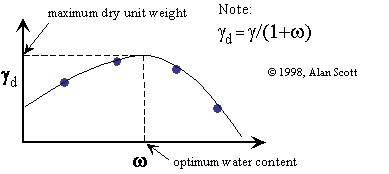Aside from the nuclear density gauge, there are a few other
methods of measuring the soil’s level of compaction, some of which would be a
balloon test as well as a sand cone test.
On most job sites the nuclear density gauge is used because of its simplicity
and speed at which results may be obtain.
While using a nuclear density gauge results can be recorded in minutes
and reported to the contractor at the job site. In comparison, the sand cone and balloon
tests can take up to a day to calculate the results.
 |
| http://www.naturalbuildingblog.com/proctor-soil-compaction-test/ |
Before any of these
tests may be used, one must first sample the soil and conduct a proctor test on
it. A proctor test is hitting the soil
with a hammer multiple times at different water contents. The varying soils at different water contents
are then dried and weighed. From this data a curve is constructed to find the maximum compaction of
the soil. The maximum compaction found
in the lab is then compared to the compaction results that the nuclear density
gauge found in the field to determine the relative compaction percentage. This comparison informs the contractor if they
need to add more water or if they need to take the water out of the soil to
compact the soil to the required compaction percentage.
| http://www.fhwa.dot.gov/engineering/geotech/pubs/05037/08.cfm |
The nuclear gauge is a very simple machine to use. However, it does use radiation to obtain its
results and should be handled with extreme care. Due to the radiation that is used in this
machine, one must go through a training to become certified to use the nuclear
density gauge. The two main sources of
radiation that the nuclear density gauge uses are cesium-137 and
americium-241. Before using the nuclear
density gauge one must calibrate it daily to the correct setting to ensure that
it is working properly before going out to the job site. The first step of using the nuclear density
gauge to measure the compaction of the soil is to prepare a hole by using a
hammer and a spike or just simply a slide hammer. After the hole has been made, you can simply
slide the rod on the nuclear density gauge into the hole exposing the
cesium-137 into the soil. After the
machine is started the cesium-137 sends out waves of gamma radiation that are
then collected by the detectors on the bottom of the gauge. The americium-241 is used to find the
moisture by calculating the dry density and wet density. The gauge then calculates and displays
relevant values such as the dry density of the soil, wet density of the soil,
compaction of the soil, and the amount of water in the soil.
 |
| https://rmcmed.com/2012/08/31/radiation/ |
To get an idea of how much radiation a gauge produces, individuals
operating the gauge are required to wear a badge that detects the
radiation. The maximum radiation that
one person can have in a given year is 5000mREM. Upon completion of my job, I submitted badge and
testing showed that I had less than 50mREM in 6 months. This shows that if the nuclear density gauge
is used properly it is a very safe machine.
Like any machine there are good and bad things about the
nuclear density gauge. The best thing
about the nuclear density gauge is the speed at which it works. If the proctor has already been finished back
in the lab the soil compaction results can be calculated in under a
minute. It is also very easy to use once
trained properly on the dangers of the radiation. However, it is rather heavy, being around
40lbs, and the extensive training that is required to handle this device may turn
some people away. Also, this machine
will not work during the rain do to the americium-241. Another downside of this gauge is the overall
cost. The machine is expensive and all
the paperwork that is required for it is also quite expensive. Overall, I would highly recommend this machine
to anyone in the field since its pros outweigh its cons. On a scale of one to five I would give the
nuclear density gauge a four.
For more information please look at the following link.
http://www.apnga.com/i_gauge_basics.html
For more information please look at the following link.
http://www.apnga.com/i_gauge_basics.html
This machines is really fascinating on how it works. Once again with the Google Glass, I feel like those glasses would be very useful in a situation like this, so coworkers back in the lab can see what is going on and take the measurements with the user and start filling out paperwork ahead of time. Although I do have one question, is there such thing as too much radiation on Earth (you know someone would ask this eventually, if it already has not been addressed)?
ReplyDeleteGood pictures, it helps a lot to actually see pictures of what someone is talking about. One thing i would be pretty nervous about using this product is the radiation. I know it produces a safe amount of radiation, but i was still be hesitant to use it.
ReplyDeleteI like how you explain the nuclear gauge, and that you need training for it. The pictures are good representation of what your explaining. It is cool that one little machine like that can tell the density of the ground!
ReplyDelete